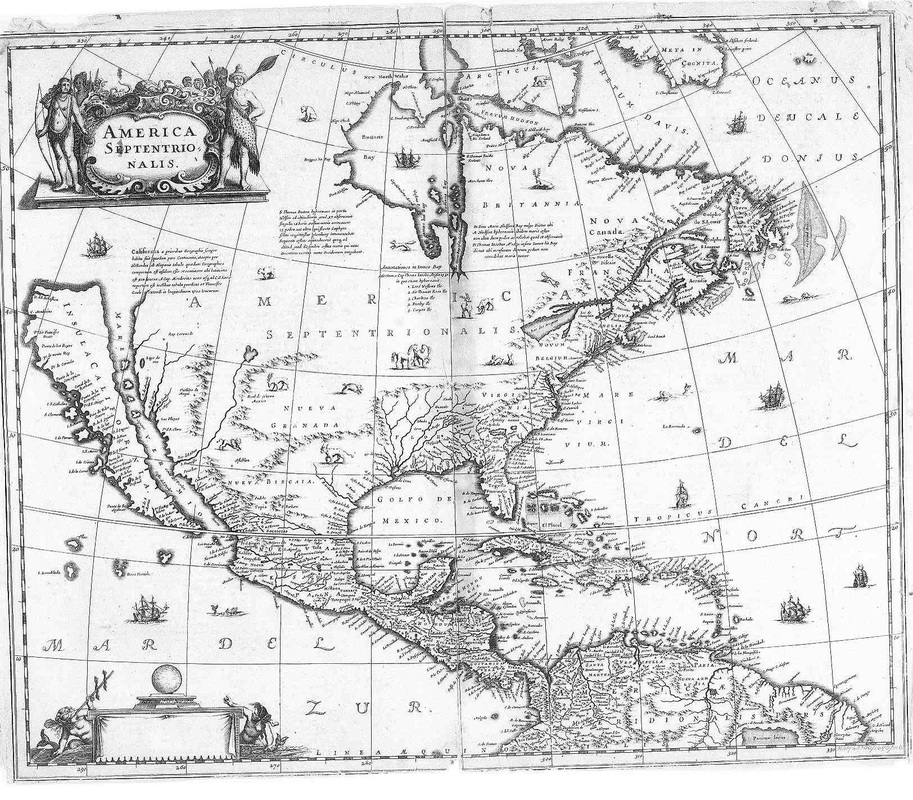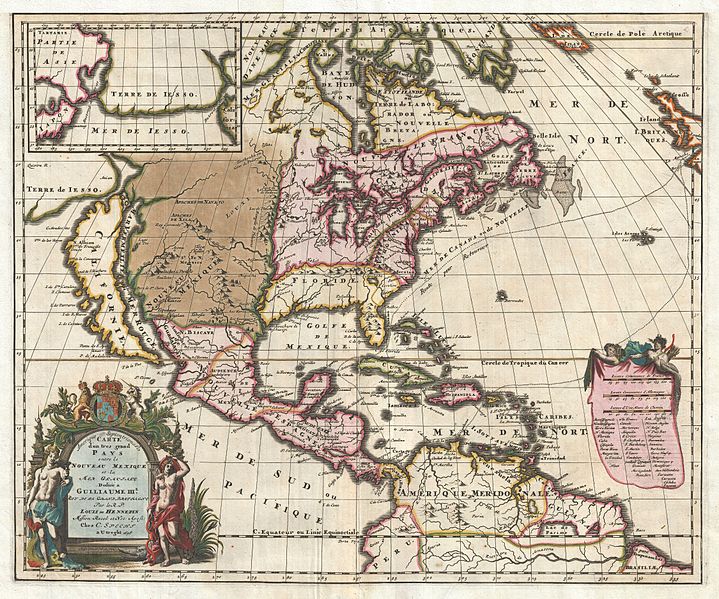|
I’ve received a few emails about Gavin Menzies’s new book, Who Discovered America? (William Morrow, 2013), which claims new evidence that the Chinese discovered America in 40,000 BCE and again in 1417. (This revises down the date from Menzies’s 2002 bestseller 1421: The Year China Discovered America). I have not read the book and therefore can’t comment on all of Menzies’s claims. However, as reported in The Daily Mail, the primary evidence he offers is the following map, which he claims is an eighteenth century copy of a 1417 original, based on a scholar’s assertion that the language used dates from the Ming Dynasty (1368-1644). As you can see, there are a few issues that immediately call into question this claim. Notice that Baja California is shown as an island. Were Chinese navigators half as great as Menzies claims, they would not have made this error. The error, in fact, derives from a Spanish myth, that of the “Island of California” which existed west of the Indies. The earliest mention of this fictional island came in 1510 and was later applied to Baja. Despite Spanish reports that Baja California was a peninsula in the 1530s and 1540s, the myth of the “Island of California” was so strong that Spanish cartographers depicted it as an island into the 1600s. Therefore, the dating of the Chinese map’s text to before 1644 and the depiction of Baja California as an island, also from the 1500s and 1600s, all but confirms that this Chinese map is derived from a Spanish original, unless one wishes to believe that the Chinese were either terrible mapmakers or otherwise could not tell an island from a peninsula despite having surveyed the entirety of America, as Menzies claims. Update: We do not need to resort to mere facts to criticize the map. As Caleb points out in the comments below, scholars who examined the map have declared it a fake, probably produced after the release of 1421 to support the book and Menzies. Of course, that could be the academic conspiracy at work!
As for his other claim, there were no ethnically Chinese people 40,000 years ago and therefore no way of declaring Native Americans the descendants of ancestral Chinese. Menzies seems to have misunderstood the idea that modern anthropology suggests that Native Americans descend from successive waves of migrants from Asia, some of which originated deeper in the continent than others at one time or another.
10 Comments
Shane Sullivan
10/9/2013 05:19:14 am
The amazon.com synopsis mentions "an ancient Asian seagoing tradition—most notably the Chinese—that dates as far back as 130,000 years ago", evidently as "a revolutionary new alternative" to the Beringia-crossing theory. Doesn't sound like he misunderstood anything; he just made up a new Atlantis.
Reply
10/9/2013 05:48:11 am
I was generously assuming he was familiar with newer ideas that suppose that some migrants to the Americas came by boat, hugging the coasts. Apparently he just makes things up. No one in mainstream archaeology doubts that the first Americans crossed over from Asia, but I'd like to see Menzies prove that there were ethnic Chinese alive 40,000 or 130,000 years ago.
Reply
Gunn
10/9/2013 06:49:39 am
I've always been interested in arrowheads and spear-points ever since I found a few arrowheads growing up in Michigan, along the Muskegon River. As a teen and young man, I read a lot (before the computer age!) about the mound-building culture, and later I studied the most recent developments concerning the Solutrean migration debate.
Reply
Caleb
10/9/2013 08:15:17 am
I am note aware of any evidence proving the authenticity of the map. The map has been declared a fake by both Western and Chinese historians. It contains obvious errors and anachronism according to at least three historical scholars that have studied the map.
Reply
10/9/2013 08:21:08 am
Thanks for the link about the map. It shouldn't surprise me that Menzies is using fake material. Just looking at it, I could tell it wasn't medieval. Now I know it's a fake. I'll add the link to the post.
Reply
10/9/2013 02:41:47 pm
you can't have any traditions going back 130,000 years or whatever because we didn't even get writing together until around Sumerian times. Of course, generations of people who occasionally went to sea might add up to a seafaring tradition, but that's a tradition of practice not of knowledge.
Reply
Only Me
10/9/2013 04:35:07 pm
You didn't at least go to the links provided by Caleb, did you? If you had, you would realize the map, is indeed, fake. That's part of the experience offered by this forum...you can look at the evidence provided by Jason or others, who have taken the time to find and link to it. From there, you can make your own determination.
Reply
Justina (Christine Erikson)
10/12/2013 03:00:07 am
I probably didn't but whatever proof (like examination of ink or paper)is there doesn't rule out that this was copied from an earlier map.
Michael Zalar
10/12/2013 02:48:59 am
One thing that I noticed immediately was the inclusion of the imagined circumpolar islands at the North Pole of the map. This was an error of 16th century European cartograpy, based on the Invetio Forturna, or perhaps the Itinerarium of Jacobus Cnoyen who supposedly included parts of the Inventio in his work.
Reply
Justina (Christine Erikson)
10/12/2013 03:02:03 am
But there are islands up there, Iceland, Greenland, the spatter of islands in the Baltic Sea and other stuff that may be gone now due to volcanic action and subsidence. Maps drawn from just sailing by aren't going to be as good as we have now, only maps of places that one uses for ports. Even so, the Mediteranean maps were not perfect, just good enough to get you there and you figure out the rest.
Reply
Your comment will be posted after it is approved.
Leave a Reply. |
AuthorI am an author and researcher focusing on pop culture, science, and history. Bylines: New Republic, Esquire, Slate, etc. There's more about me in the About Jason tab. Newsletters
Enter your email below to subscribe to my newsletter for updates on my latest projects, blog posts, and activities, and subscribe to Culture & Curiosities, my Substack newsletter.
Categories
All
Terms & ConditionsPlease read all applicable terms and conditions before posting a comment on this blog. Posting a comment constitutes your agreement to abide by the terms and conditions linked herein.
Archives
July 2024
|
- Home
- Blog
- Books
-
Articles
-
Newsletter
>
- Television Reviews >
- Book Reviews
- Galleries >
- Videos
-
Collection: Ancient Alien Fraud
>
- Chariots of the Gods at 50
- Secret History of Ancient Astronauts
- Of Atlantis and Aliens
- Aliens and Ancient Texts
- Profiles in Ancient Astronautics >
- Blunders in the Sky
- The Case of the False Quotes
- Alternative Authors' Quote Fraud
- David Childress & the Aliens
- Faking Ancient Art in Uzbekistan
- Intimations of Persecution
- Zecharia Sitchin's World
- Jesus' Alien Ancestors?
- Extraterrestrial Evolution?
- Collection: Skeptic Magazine >
- Collection: Ancient History >
- Collection: The Lovecraft Legacy >
- Collection: UFOs >
- Scholomance: The Devil's School
- Prehistory of Chupacabra
- The Templars, the Holy Grail, & Henry Sinclair
- Magicians of the Gods Review
- The Curse of the Pharaohs
- The Antediluvian Pyramid Myth
- Whitewashing American Prehistory
- James Dean's Cursed Porsche
-
Newsletter
>
-
The Library
-
Ancient Mysteries
>
-
Ancient Texts
>
- Mesopotamian Texts >
-
Egyptian Texts
>
- The Shipwrecked Sailor
- Dream Stela of Thutmose IV
- The Papyrus of Ani
- Classical Accounts of the Pyramids
- Inventory Stela
- Manetho
- Eratosthenes' King List
- The Story of Setna
- Leon of Pella
- Diodorus on Egyptian History
- On Isis and Osiris
- Famine Stela
- Old Egyptian Chronicle
- The Book of Sothis
- Horapollo
- Al-Maqrizi's King List
- Teshub and the Dragon
- Hermetica >
- Hesiod's Theogony
- Periplus of Hanno
- Ctesias' Indica
- Sanchuniathon
- Sima Qian
- Syncellus's Enoch Fragments
- The Book of Enoch
- Slavonic Enoch
- Sepher Yetzirah
- Tacitus' Germania
- De Dea Syria
- Aelian's Various Histories
- Julius Africanus' Chronography
- Eusebius' Chronicle
- Chinese Accounts of Rome
- Ancient Chinese Automaton
- The Orphic Argonautica
- Fragments of Panodorus
- Annianus on the Watchers
- The Watchers and Antediluvian Wisdom
-
Medieval Texts
>
- Medieval Legends of Ancient Egypt >
- The Hunt for Noah's Ark
- Isidore of Seville
- Book of Liang: Fusang
- Agobard on Magonia
- Book of Thousands
- Voyage of Saint Brendan
- Power of Art and of Nature
- Travels of Sir John Mandeville
- Yazidi Revelation and Black Book
- Al-Biruni on the Great Flood
- Voyage of the Zeno Brothers
- The Kensington Runestone (Hoax)
- Islamic Discovery of America
- The Aztec Creation Myth
-
Lost Civilizations
>
-
Atlantis
>
- Plato's Atlantis Dialogues >
- Fragments on Atlantis
- Panchaea: The Other Atlantis
- Eumalos on Atlantis (Hoax)
- Gómara on Atlantis
- Sardinia and Atlantis
- Santorini and Atlantis
- The Mound Builders and Atlantis
- Donnelly's Atlantis
- Atlantis in Morocco
- Atlantis and the Sea Peoples
- W. Scott-Elliot >
- The Lost Atlantis
- Atlantis in Africa
- How I Found Atlantis (Hoax)
- Termier on Atlantis
- The Critias and Minoan Crete
- Rebuttal to Termier
- Further Responses to Termier
- Flinders Petrie on Atlantis
- Amazing New Light (Hoax)
- Lost Cities >
- OOPARTs
- Oronteus Finaeus Antarctica Map
- Caucasians in Panama
- Jefferson's Excavation
- Fictitious Discoveries in America
- Against Diffusionism
- Tunnels Under Peru
- The Parahyba Inscription (Hoax)
- Mound Builders
- Gunung Padang
- Tales of Enchanted Islands
- The 1907 Ancient World Map Hoax
- The 1909 Grand Canyon Hoax
- The Interglacial Period
- Solving Oak Island
-
Atlantis
>
- Religious Conspiracies >
-
Giants in the Earth
>
-
Fossil Origins of Myths
>
- Fossil Teeth and Bones of Elephants
- Fossil Elephants
- Fossil Bones of Teutobochus
- Fossil Mammoths and Giants
- Giants' Bones Dug Out of the Earth
- Fossils and the Supernatural
- Fossils, Myth, and Pseudo-History
- Man During the Stone Age
- Fossil Bones and Giants
- Mastodon, Mammoth, and Man
- American Elephant Myths
- The Mammoth and the Flood
- Fossils and Myth
- Fossil Origin of the Cyclops
- History of Paleontology
- Fragments on Giants
- Manichaean Book of Giants
- Geoffrey on British Giants
- Alfonso X's Hermetic History of Giants
- Boccaccio and the Fossil 'Giant'
- Book of Howth
- Purchas His Pilgrimage
- Edmond Temple's 1827 Giant Investigation
- The Giants of Sardinia
- Giants and the Sons of God
- The Magnetism of Evil
- Tertiary Giants
- Smithsonian Giant Reports
- Early American Giants
- The Giant of Coahuila
- Jewish Encyclopedia on Giants
- Index of Giants
- Newspaper Accounts of Giants
- Lanier's A Book of Giants
-
Fossil Origins of Myths
>
-
Science and History
>
- Halley on Noah's Comet
- The Newport Tower
- Iron: The Stone from Heaven
- Ararat and the Ark
- Pyramid Facts and Fancies
- Argonauts before Homer
- The Deluge
- Crown Prince Rudolf on the Pyramids
- Old Mythology in New Apparel
- Blavatsky on Dinosaurs
- Teddy Roosevelt on Bigfoot
- Devil Worship in France
- Maspero's Review of Akhbar al-zaman
- The Holy Grail as Lucifer's Crown Jewel
- The Mutinous Sea
- The Rock Wall of Rockwall
- Fabulous Zoology
- The Origins of Talos
- Mexican Mythology
- Chinese Pyramids
- Maqrizi's Names of the Pharaohs
-
Extreme History
>
- Roman Empire Hoax
- American Antiquities
- American Cataclysms
- England, the Remnant of Judah
- Historical Chronology of the Mexicans
- Maspero on the Predynastic Sphinx
- Vestiges of the Mayas
- Ragnarok: The Age of Fire and Gravel
- Origins of the Egyptian People
- The Secret Doctrine >
- Phoenicians in America
- The Electric Ark
- Traces of European Influence
- Prince Henry Sinclair
- Pyramid Prophecies
- Templars of Ancient Mexico
- Chronology and the "Riddle of the Sphinx"
- The Faith of Ancient Egypt
- Remarkable Discoveries Within the Sphinx (Hoax)
- Spirit of the Hour in Archaeology
- Book of the Damned
- Great Pyramid As Noah's Ark
- Richard Shaver's Proofs
-
Ancient Texts
>
-
Alien Encounters
>
-
US Government Ancient Astronaut Files
>
- Fortean Society and Columbus
- Inquiry into Shaver and Palmer
- The Skyfort Document
- Whirling Wheels
- Denver Ancient Astronaut Lecture
- Soviet Search for Lemuria
- Visitors from Outer Space
- Unidentified Flying Objects (Abstract)
- "Flying Saucers"? They're a Myth
- UFO Hypothesis Survival Questions
- Air Force Academy UFO Textbook
- The Condon Report on Ancient Astronauts
- Atlantis Discovery Telegrams
- Ancient Astronaut Society Telegram
- Noah's Ark Cables
- The Von Daniken Letter
- CIA Psychic Probe of Ancient Mars
- Scott Wolter Lawsuit
- UFOs in Ancient China
- CIA Report on Noah's Ark
- CIA Noah's Ark Memos
- Congressional Ancient Aliens Testimony
- Ancient Astronaut and Nibiru Email
- Congressional Ancient Mars Hearing
- House UFO Hearing
- Ancient Extraterrestrials >
- A Message from Mars
- Saucer Mystery Solved?
- Orville Wright on UFOs
- Interdimensional Flying Saucers
- Poltergeist UFOs
- Flying Saucers Are Real
- Report on UFOs
-
US Government Ancient Astronaut Files
>
-
The Supernatural
>
- The Devils of Loudun
- Sublime and Beautiful
- Voltaire on Vampires
- Demonology and Witchcraft
- Thaumaturgia
- Bulgarian Vampires
- Religion and Evolution
- Transylvanian Superstitions
- Defining a Zombie
- Dread of the Supernatural
- Vampires
- Werewolves and Vampires and Ghouls
- Science and Fairy Stories
- The Cursed Car
-
Classic Fiction
>
- Lucian's True History
- Some Words with a Mummy
- The Coming Race
- King Solomon's Mines
- An Inhabitant of Carcosa
- The Xipéhuz
- Lot No. 249
- The Novel of the Black Seal
- The Island of Doctor Moreau
- Pharaoh's Curse
- Edison's Conquest of Mars
- The Lost Continent
- Count Magnus
- The Mysterious Stranger
- The Wendigo
- Sredni Vashtar
- The Lost World
- The Red One
- H. P. Lovecraft >
- The Skeptical Poltergeist
- The Corpse on the Grating
- The Second Satellite
- Queen of the Black Coast
- A Martian Odyssey
- Classic Genre Movies
-
Miscellaneous Documents
>
- The Balloon-Hoax
- A Problem in Greek Ethics
- The Migration of Symbols
- The Gospel of Intensity
- De Profundis
- The Life and Death of Crown Prince Rudolf
- The Bathtub Hoax
- Crown Prince Rudolf's Letters
- Position of Viking Women
- Employment of Homosexuals
- James Dean's Scrapbook
- James Dean's Love Letters
- The Amazing James Dean Hoax!
- James Dean, The Human Ashtray
- Free Classic Pseudohistory eBooks
-
Ancient Mysteries
>
- About Jason
- Search
© 2010-2024 Jason Colavito. All rights reserved.







 RSS Feed
RSS Feed
